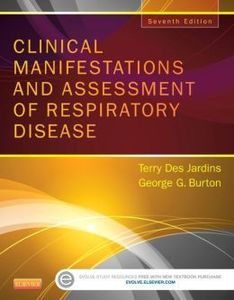Get a deeper understanding of respiratory disease with Clinical Manifestations and Assessment of Respiratory Disease,
7th Edition. This popular, full-color text provides all the necessary tools you need to learn how to gather clinical
data, formulate assessments, make objective evaluations, identify desired outcomes, design a safe and effective
treatment plan, and document all the steps involved. Using easy-to-follow language and relevant clinical scenarios,
this text gives readers a firm understanding of why certain treatment modalities are applied. And with a new chapter on
respiratory failure and mechanical ventilation protocol, new information on electronic charting, and numerous updates
in treatment and assessment added to nearly all the chapters, this new edition ensures you will be well-versed in all
of the new issues affecting respiratory therapy.
• UNIQUE! Emphasis on clinical scenarios and critical thinking skills illustrates the causes of the clinical
manifestations activated by specific respiratory disorders.
• UNIQUE! Focus on assessment and Therapist-Driven Protocols (TDPs) emphasizes industry-approved standards of care,
providingreaders with the knowledge and skills to implement these protocols into patient care.
• Case studies provide realistic examples of the respiratory therapist’s role in successful patient care and readers
apply text information to clinical assessment and treatment.
• Self-assessment questions at the end of the text help readers personally assess their understanding of chapter
material.
• Overview boxes summarize the clinical manifestations caused by the pathophysiologic mechanisms of each disorder.
• Student-friendly features reinforce learning with chapter outlines, objectives, key terms, and easy-to-follow
language.
• NEW! New chapter on respiratory failure and mechanical ventilation protocol outlines the respiratory therapist’s
role in regards to these protocols.
• NEW! New chapters on congenital diaphragmatic hernia and congenital heart disease
• NEW! Updated content on electronic charting offers the latest guidelines for collecting and recording respiratory
assessments and treatment plans using an electronic health record.
• NEW! The most up-to-date content throughout ensures readers are well-versed in the latest assessment and treatment
guidelines for various respiratory illnesses and injuries.
• NEW! Therapist-driven protocols (TDPs) information is now separated into two chapters to divide content between the
basic treatment protocols and the protocols for mechanical ventilation and weaning from the ventilator.
-도서목차-
PART I: ASSESSMENT OF RESPIRATORY DISEASE Section I: Clinical Data Obtained at the Patient’s Bedside 1.The Patient
Interview 2.The Physical Examination and Its Basis in Physiology Section II: Clinical Data Obtained from Laboratory
Tests and Special Procedures 3.Pulmonary Function Study Assessments 4.Arterial Blood Gas Assessments 5.Oxygenation
Assessments 6.Cardiovascular System Assessments 7.Radiologic Examination of the Chest 8.Other Important Tests and
Procedures Section III: The Therapist-Driven Protocol Program - The Essentials 9.The Therapist-Driven Protocol Program
and the Role of the Respiratory Care Practitioner 10.Respiratory Failure and the Mechanical Ventilation Protocol NEW!
11.Recording Skills: The Basis for Data Collection, Organization, Assessment PART II: OBSTRUCTIVE AIRWAY DISEASES
12.Chronic Obstructive Pulmonary Disease (COPD): Chronic Bronchitis and Emphysema 13.Asthma 14.Bronchiectasis 15.Cystic
Fibrosis PART III: INFECTIOUS PULMONARY DISEASES 16.Pneumonia 17.Lung Abscess 18.Tuberculosis 19.Fungal Diseases of the
Lung PART IV: PULMONARY VASCULAR DISEASES 20.Pulmonary Edema 21.Pulmonary Embolism and Infarction PART V: CHEST AND
PLEURAL TRAUMA 22.Flail Chest 23.Pneumothorax PART VI: DISORDERS OF THE PLEURA AND OF THE CHEST WALL 24.Pleural
Effusion and Empyema 25.Kyphoscoliosis PART VII: ENVIRONMENTAL LUNG DISEASES 26.Interstitial Lung Diseases (ILD) PART
VIII: NEOPLASTIC DISEASE 27.Cancer of the Lung PART IX: DIFFUSE ALVEOLAR DISEASE 28.Acute Respiratory Distress Syndrome
PART X: NEUROLOGIC DISORDERS AND SLEEP APNEA 29.Guillain-Barré Syndrome 30.Myasthenia Gravis 31.Sleep Apnea PART XI:
NEWBORN AND EARLY CHILDHOOD RESPIRATORY DISORDERS 32.Newborn and Early Childhood Respiratory Disorders and Treatment
Protocols 33.Meconium Aspiration Syndrome 34.Transient Tachypnea of the Newborn 35.Respiratory Distress Syndrome
36.Pulmonary Air Leak Syndromes 37.Respiratory Syncytial Virus (Bronchiolitis or Pneumonitis) 38.Bronchopulmonary
Dysplasia 39.Congenital Diaphragmatic Hernia 40.Congenital Heart Disease 41.Croup Syndrome: Laryngotracheobronchitis
and Acute Epiglottitis PART XII: OTHER IMPORTANT TOPICS 42.Near Drowning 43.Smoke Inhalation and Thermal Injuries
44.Postoperative Atelectasis Appendix I Symbols and Abbreviations Commonly Used in Respiratory Physiology Appendix II
Agents Used to Treat Bronchospasm and Airway Inflammation Appendix III Antibiotics Appendix IV Antifungal Agents
Appendix V Mucolytic and Expectorant Agents Appendix VI Positive Inotropes and Vasopressors Appendix VII Diuretic
Agents Appendix VIII The Ideal Alveolar Gas Equation Appendix IX Physiologic Dead Space Calculation Appendix X Units of
Measure Appendix XI Poiseuille’s Law Appendix XII PCO2/HCO3_/pH Nomogram Appendix XIII Calculated Hemodynamic
Measurements Appendix XIV DuBois Body Surface Area Chart Appendix XV Cardiopulmonary Profile Glossary


